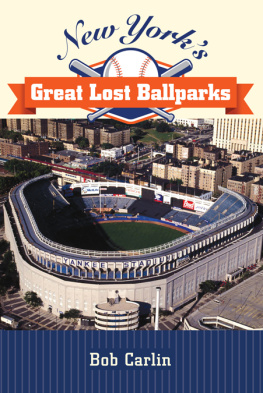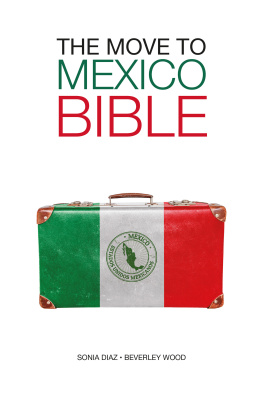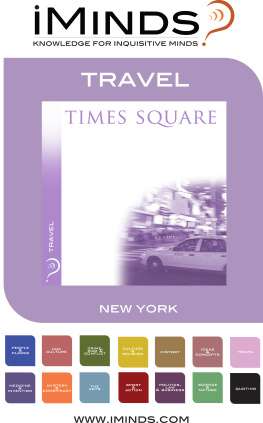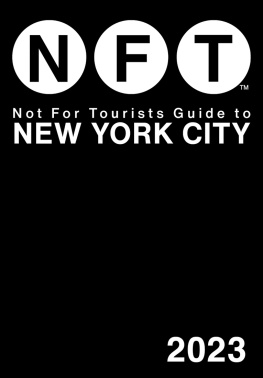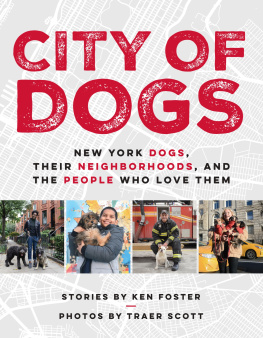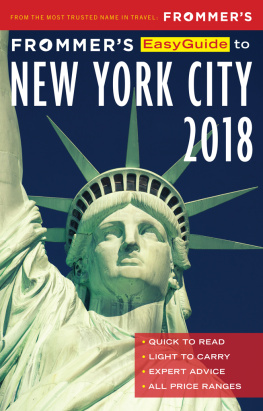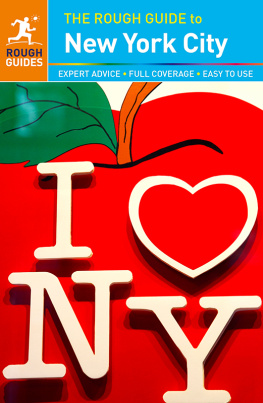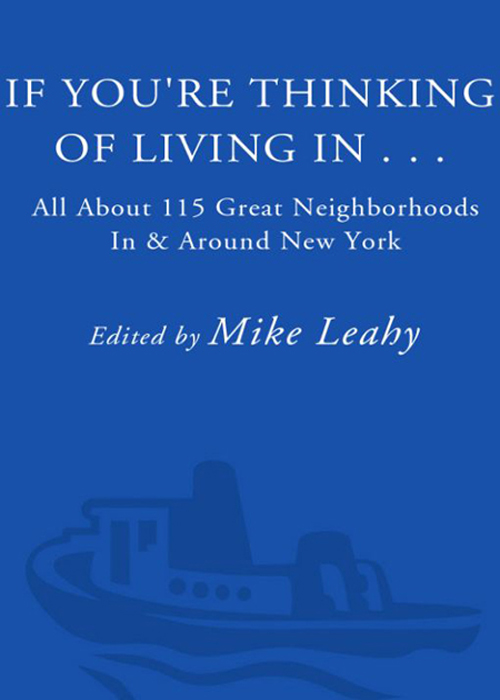

Table of Contents
New York City
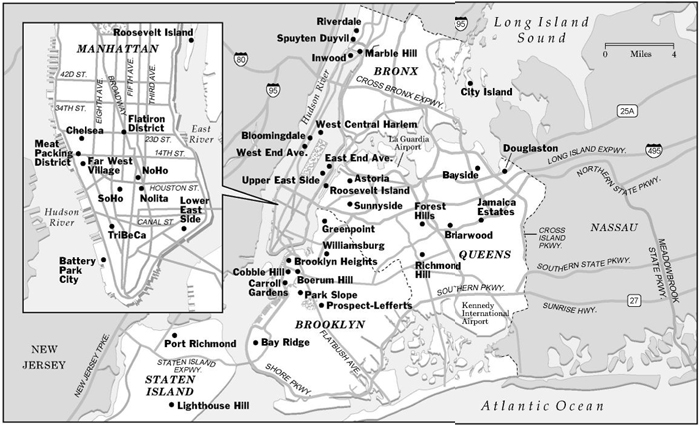
MANHATTAN
Battery Park City
Bloomingdale
Chelsea
East End Avenue
The Far West Village
Inwood
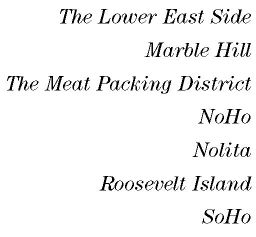
TriBeCA
The Upper East Side
West Central Harlem
West End Avenue
THE BRONX
City Island
Riverdale
Sputen Duyvil
BROOKLYN
Bay Ridge
Boerum Hill
Brooklyn Heights
Carroll Gardens
Cobble Hill
Greenpoint
Park Slope
Prospect Lefferts Gardens
Williamsburg
QUEENS
Astoria
Bayside
Briarwood
Douglaston
Forest Hills Gardens
Jamaica Estates
Richmond Hill
Sunnyside
STATEN ISLAND
Lighthouse Hill
Port Richmond
INTRODUCTION
One of the pleasures of walking along Manhattans streets is the mix of people rushing, strolling, or idling by. Mink-coated and pin-striped, wearing ragged jeans (but just-so in their raggedness) and purple hair, buttoned-down and laid-back, all share the same space. It is a variety that also marks the housing choices available to those who live in New York City and its suburbs.
These neighborhoods, hamlets, villages, towns, and cities each have their own personalities, though, like members of sprawling families or clans, their similarities are frequently as striking as their differences. There are few guideposts to these individual personalities, and those that exist are sometimes hard to decipher. Classified ads are a helphouse descriptions and figures preceded by dollar signs quickly direct most house hunters in making some basic decisionsbut even these are frequently written in code. In the city, an apartment described as having a townhouse feel probably means that it is on a low floor. The phrase lots of light frequently translates to no view. Whether in city or country, riv vu may assume a contortionists ability to swivel the neck. References to t.l.c. have nothing to do with the Taxi and Limousine Commission, except to suggest a blinking yellow caution light. And, of course, needs work invariably means needs lots of work.
Names may or may not provide clues. Manhattans West End Avenue, a block from the bustle of Broadway, seems to occupy a different universe from that of the tranquil (some West Siders would say dull) high-rise village of East End Avenue. Brooklyn Heights and Staten Islands Lighthouse Hill do, as their names suggest, offer splendid views, but the names of Manhattans TriBeCa and New Jerseys Ho-Ho-Kus are more puzzling than descriptive. On Long Island, Port Washington, Port Jefferson, Northport, Centerport, and Oyster Bay accurately suggest nautical surroundings, but Locust Valley may put those unfamiliar with its leafy privileged lanes in mind of less appealing biblical images. For those who live in them, however, the New Jersey communities of Alpine and Summit may well occupy the housing niches that these names suggest.
In many New York suburbs, looks and boundary lines can be misleading. Identical-seeming houses on the same street will sell for differences of tens of thousands of dollars because they are in different towns or school districts. Many towns are served by more than one school district, and the differences in reputations of the districts will translate into significant differences in housing prices. Access to such desirable facilities as golf clubs and beaches may be controlled by the municipal boundary lines that run through otherwise identical neighborhoods. Taxes can vary sharply from municipality to municipality, even when a visitor would be hard put to see many differences between them.
All of these factors are part of what makes each community different from its neighbors. Beyond these attributes, though, are others that are harder to measure, but that give each place its personality. The hamlet of South Salem, just an hour from Manhattan, takes part of its Norman Rockwell character from a town center consisting of a general store, an antiques shop, and the remnants of a one-pump gas station that no longer operates; across the street, standing on a slight rise, is the South Salem Presbyterian Church. Part of the character of the surrounding boomerang-shaped Town of Lewisboro comes from a network of horse trails allowing riders free access to 1,500 acres of private property. The Long Island village of Northport has chosen to preserve the tracks of the long-departed trolleys along a still-thriving Main Street that leads down to Long Island Sound.
Montclair, with its wide range of housing, its stress on education, and its devotion to making multiracial society more than a lip-service term, has long drawn so many former Manhattan residents that it is known as the Upper West Side of New Jersey. The space and modest rents of the Brooklyn neighborhood of Williamsburg have helped form an urban mix that includes Polish immigrants, Italian, Hispanic, and Hasidic families, and artists (some of whose works are exhibited in the Brooklyn Brewerys gallery), all one subway stop away from Manhattan. The Tudor half-timbers, extensive brickwork, and red-tiled roofs of the Queens neighborhood of Forest Hills Gardens owe much to the turn-of-the-century Garden Cities movement. Nearby, in the heart of another Queens neighborhood, the 600 two-story row houses of Sunnyside Gardens cluster around landscaped gardens in one of the first planned communities in the United States, a 77-acre enclave that is listed in the National Register of Historic Places.
Every week since March 28, 1982, writers for the Real Estate section of The New York Times have set out to describe the communities of the New York area, seeking to identify and describe such specifics as the costs of homes, school spending, and local history, as well as such harder-todefine qualities as the look and feel of the neighborhoods and the ways in which they are changing, or keeping the qualities that have drawn residents to live in them. This book collects 115 of these pieces, all of which have been updated.
A word about the statistics used in this book: All are current as of the end of 1997 or early 1998, with a few figures from mid-1998. And all will surely be out of date by the time you read thisthough whether the current figures will be much different from these, or even if they will be higher or lower, is impossible to forecast. Despite their seeming precision, real estate statistics can only approximate a market. In the suburbs, multiple-listing services make a thorough and conscientious effort to track prices, but not every house is sold through agents whose real estate brokerages are members of those services. In New York City, unlike most other real estate markets in the United States, there is no comprehensive multiple-listing service. And sales of the co-op apartments that are a major part of the housing market in New York City, especially in Manhattan, are not a matter of public record; our figures for these sales are estimates from a variety of real estate brokerages. Gazetteer figures for taxes on median-priced houses are approximations; property taxes can vary markedly on houses selling for roughly the same price. In a few cases, where the data were insufficient or misleading, the estimates were omitted. Estimates of population and median household income were prepared by the Queens College Applied Social Research Program, and are as of 1997.
Next page

